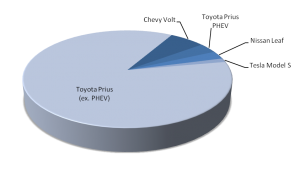Although sales of electric vehicle in the U.S. in 2012 were much stronger than in the previous year, they were barely noticeable, accounting for less  than 0.5% of the 14.5 million cars and light duty trucks sold during the year. With some exceptions, public interest in owning EVs, seems to be dwindling.
than 0.5% of the 14.5 million cars and light duty trucks sold during the year. With some exceptions, public interest in owning EVs, seems to be dwindling.
A few years ago, General Motors decided to bet on electric propulsion as part of its recovery strategy, in part perhaps because worldwide sales of EVs, especially in China, are expected to grow over the next decade. GM elected to enter the market with the Chevy badge, targeting the demographic of market leader Toyota Prius, and planning to leverage the global presence of Chevy in future high demand markets.
Bob Lutz, the former GM Vice Chairman who led the development of the Volt often referred to the Volt as the most important product for GM. The Volt was brought to market in only two years, which is record time for a car with that level of technology innovation. Perhaps Lutz’s promise to finally retire once the Volt has been launched had something to do with it?
The Volt’s sales, while strong, are still well below GM’s expectations and far from being able to make a meaningful dent in the dominance of Toyota’s Prius. Trying to catch up, GM recently cut the price of the 2013 Chevrolet Volt by $4,000 and nearly doubled the production capacity of the Volt production line. But Toyota’s vehicles, including Prius and other hybrids, and the recently announced plug-in hybrid (PHEV), continue to dominate the market in the U.S.
So GM is signaling a change in tack and going to offer an extended range electric Cadillac, the ELR, presumably to attract more affluent buyers that perhaps prefer the luxary image of Cadillac. At the time, Lutz objected to it because of the lack of brand appeal outside of North America.
The problem with this strategy is that it positions the ELR awkwardly between the popular Toyota Prius and the media darling Tesla Model S, but with hardly enough reason for anyone to switch brands. A low cost Cadillac priced to compete with the Prius will also compete with the Volt, diluting the value of both badges and of the entire portfolio. GM is obviously delighted with the success of the rejuvenated Cadillac brand, but using it to save GM’s EV strategy isn’t such a good idea.
GM has to figure out how to deal with the growing strength of Tesla. Although Tesla sold less than 5,000 vehicles in 2012, it reported a 13,000 unit backlog and has the manufacturing capacity, presumably 20,000 units per year, to deliver it. The growth in Tesla’s market share will come from the same segment GM targets the ELR for.
However, GM has several advantages and opportunities to compete against Tesla’s cars thanks to its retail and service network, and the practicality of the range extending gasoline engine.
Tesla has to clear a number of hurdles before it can reach profitable market adoption outside the high income urban demographics. Currently, the company does not have retail and service network. Recently, Tesla recalled Model S cars manufactured between May 10 and June 8. The campaign required driving to a customer location to pick up the vehicle and to deliver it after the repair work. The company is also in an ongoing battle with NADA, franchised car dealers and state regulators to allow it to sell direct to consumers.
Also, despite Tesla’s ongoing efforts to build up its charging infrastructure, the practicality of the Model S outside these urban areas is still limited. Both the ELR and the Volt have a longer practical driving range that the Model S, because they can revert to gasoline when needed. The Model S can reach 300 miles with the largest capacity battery available. This means you can go only 150 miles or so before you have to turn back. The Volt can travel only 40 miles on a single charge, but with the auxiliary gasoline engine it can reach 300 miles although, obviously, the performance under gasoline engine compared to the Model S will be quite anemic.
GM should use the range advantage, coupled with its service network and the lower sticker price to drive sales and establish stronger brand presence, while Tesla is fighting court battles and building the charging infrastructure. The Tesla brand will no doubt continue to attract certain demographics, but the bigger market will go to the Volt.
As for the Prius PHEV, it looks like with its puny 4.4 kW/hr battery which gives it a meager 6 mile range, it may not be able to limp to the starting line.
